Physical Address
304 North Cardinal St.
Dorchester Center, MA 02124
Physical Address
304 North Cardinal St.
Dorchester Center, MA 02124
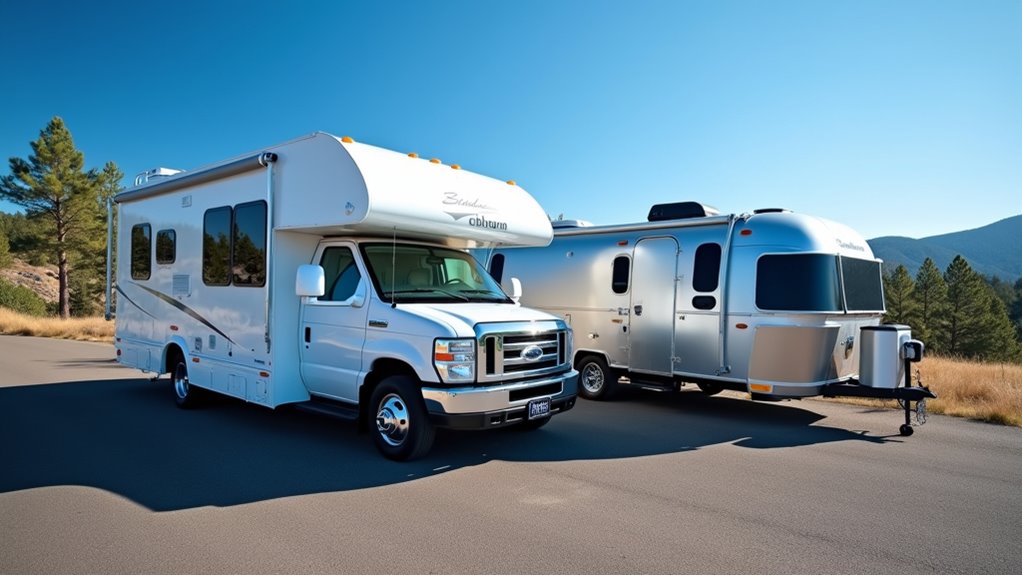
Insider secrets reveal which rental option saves thousands while avoiding common pitfalls that trap first-time adventurers.
You’re planning your next adventure and facing an essential decision: should you rent an RV or go with a trailer? Both options can transform your travel experience, but they come with vastly different costs, requirements, and trade-offs. Your choice will impact everything from your upfront budget to fuel expenses, towing capabilities, and storage needs. Before you commit to either option, there’s a strategic framework that’ll help you avoid costly mistakes and choose what’s actually right for your situation.
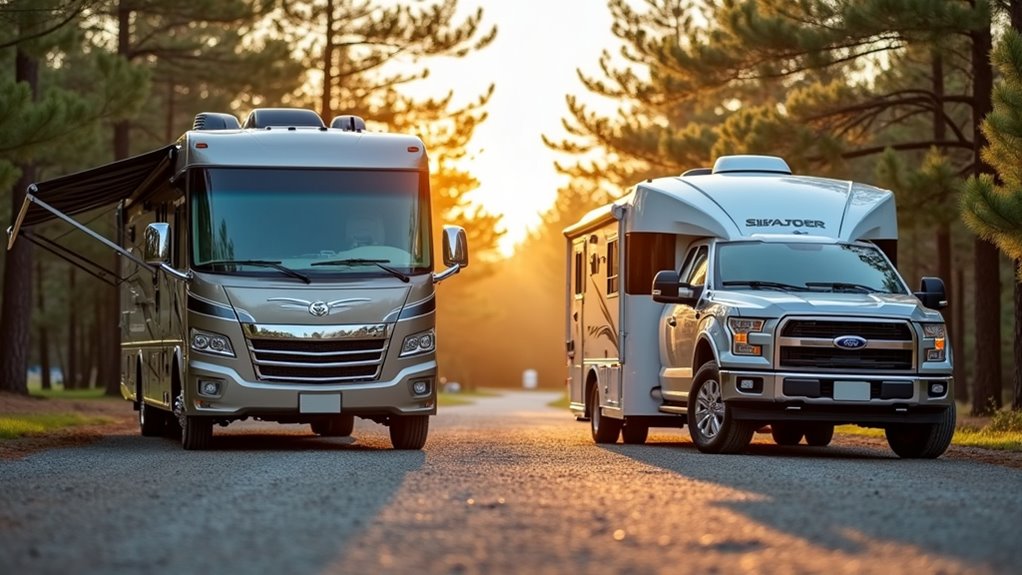
When you’re weighing your vacation options, the cost difference between RV and trailer rentals can make or break your budget. Travel trailers offer the most affordable entry point at $50–$200 per night, while Class A motorhomes can cost $150–$450 nightly. However, don’t let trailer pricing fool you—you’ll need a capable towing vehicle and must factor in fuel costs for hauling. RV rentals typically include mileage fees and significant fuel expenses, but they bundle driving and living space together. Trailers require separate towing arrangements, insurance, and additional fuel calculations. Plus, consider the maintenance and setup requirements associated with trailers, which can add to your overall costs and planning time. Weekly rates show the gap clearly: trailers run $400–$700 compared to motorhomes at $1,050–$3,150. Your total vacation cost depends on seasonal timing, destination popularity, and vehicle size—not just the base rental rate. Peak travel seasons like spring break and summer typically drive prices significantly higher across all rental categories.
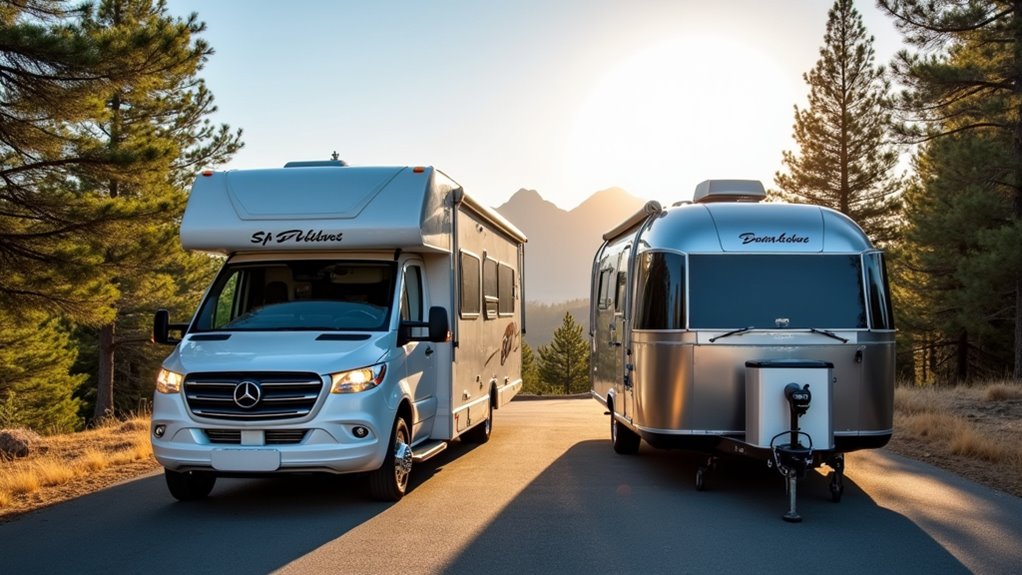
The sheer variety of RV and trailer options can overwhelm first-time renters, but understanding each type’s strengths helps you match your choice to your specific needs and budget. Travel trailers work well for families, sleeping up to 10 people in 20-35 feet of space. You’ll need a sturdy tow vehicle, but you’ll get full amenities at $20,000-$35,000. Pop-up campers offer budget-friendly options at $10,000-$25,000, perfect for smaller vehicles. Class A motorhomes provide luxury but cost $75,000-$250,000, while Class B units offer easier maneuverability at $100,000-$150,000. Fifth wheels deliver stability and space but require truck bed attachment. These units range from 21-40 feet and can accommodate up to 8 people for extended stays. Consider teardrop trailers for couples seeking simplicity, or truck campers for off-road adventures. Matching sleeping capacity, amenities, and towing requirements to your trip plans is essential for a successful trip.

Beyond the advertised nightly rate, RV rental costs can quickly spiral with fees that many first-time renters don’t see coming.
Hidden fees can transform what seemed like an affordable RV rental into a budget-busting nightmare for unsuspecting first-time renters.
You’ll face mileage charges ranging from $0.25 to $0.75 per mile, which can devastate your budget on longer trips. Generator usage, insurance premiums, and preparation fees add another layer of expenses you weren’t expecting.
The base rates vary dramatically: Class A motorhomes run $150-$450 nightly, while pop-up campers start at just $30. Travel trailers fall somewhere between at $50-$200 per night.
However, don’t forget towing fees if you’re renting a trailer without owning a capable vehicle. Fuel costs also vary significantly, with smaller RVs achieving 10-15 miles per gallon while larger RVs can average 4-6 miles per gallon. Plus, some rental companies charge mandatory cleaning fees that can increase your total cost unexpectedly.
Weekly rentals offer better value, with travel trailers costing $820-$2,910 depending on age and condition.
Always request a complete fee breakdown before signing.

Rental fees might seem intimidating, but owning an RV or trailer brings its own financial reality that many buyers underestimate.
Here’s what you’ll face with long-term ownership:
Your break-even point depends entirely on how often you’ll actually use it. When compared to hotel stays averaging $125 per night, RVing becomes economical at a break-even campsite cost of $101 per night.
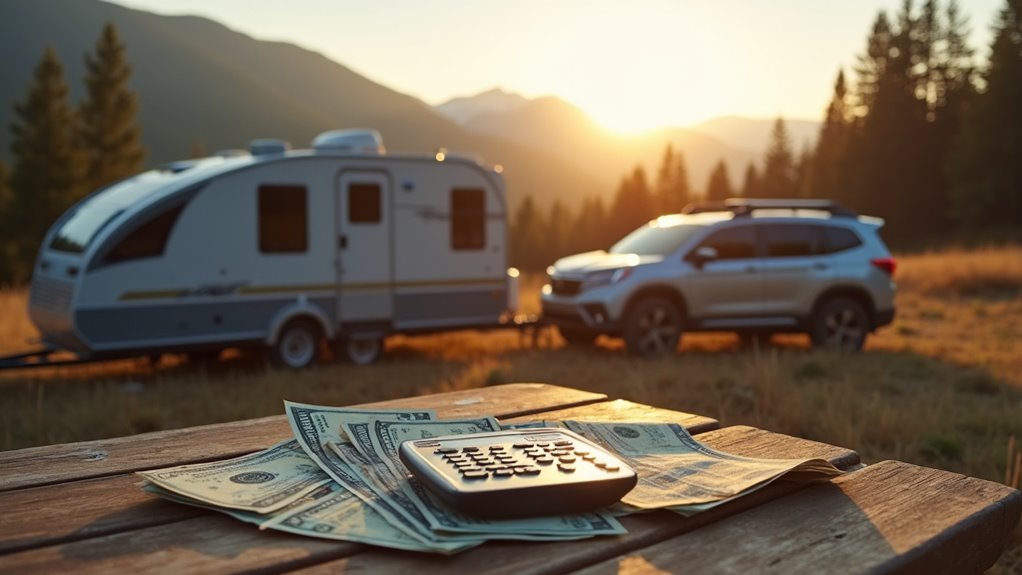
When you crunch the numbers on vacation costs, RV travel delivers substantial savings that make ownership costs look more attractive. You’ll save 48-49% compared to flying and staying in hotels, with Class B motorhomes offering the best daily cost reductions. Even against driving and hotel combinations, you’re looking at 34-35% savings, while Airbnb comparisons still favor RVs by 27%. Your savings multiply with longer trips since daily RV costs stay consistently lower than traditional accommodations. Destination choice matters too – expensive hotel markets amplify your RV advantages. Travel trailers often provide the biggest bang for your buck, despite higher upfront costs. These savings remain stable even if fuel costs spike, since gas would need to reach $17-18 per gallon before RV travel becomes more expensive than traditional methods. Plus, understanding ownership costs can help you better evaluate the true savings of RV travel versus other options. These vacation savings can quickly offset your RV investment, especially if you’re taking multiple trips yearly or extended vacations.
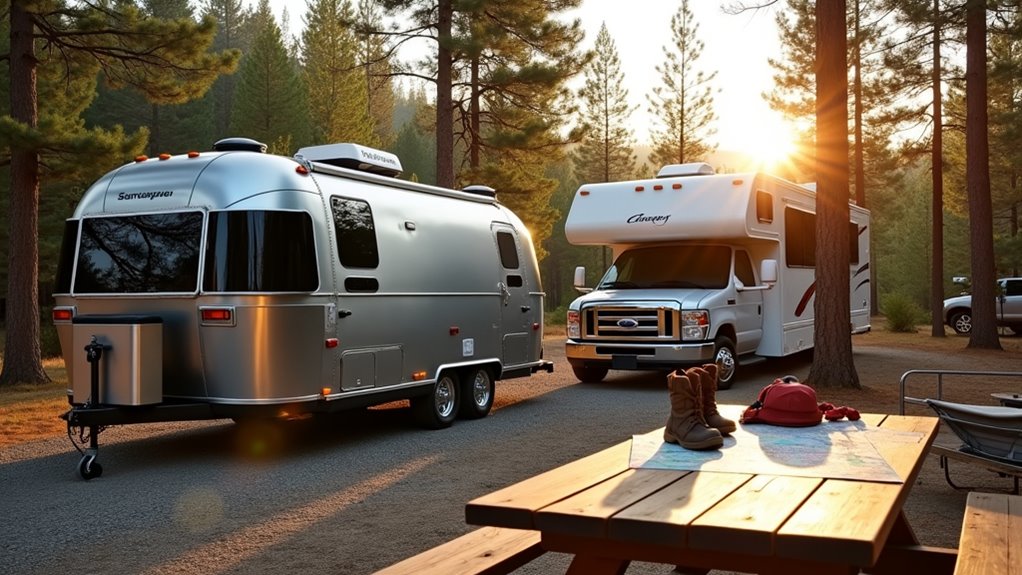
How often you hit the road and for how long directly impacts whether you should rent or buy an RV. Your travel patterns determine which option saves you more money and hassle.
Consider these key factors when evaluating your travel habits:
The breakeven point for renting occurs at approximately 47 nights per year at $275 per night, which helps determine when ownership becomes financially advantageous.
Match your travel frequency and duration to the most cost-effective option for your budget.
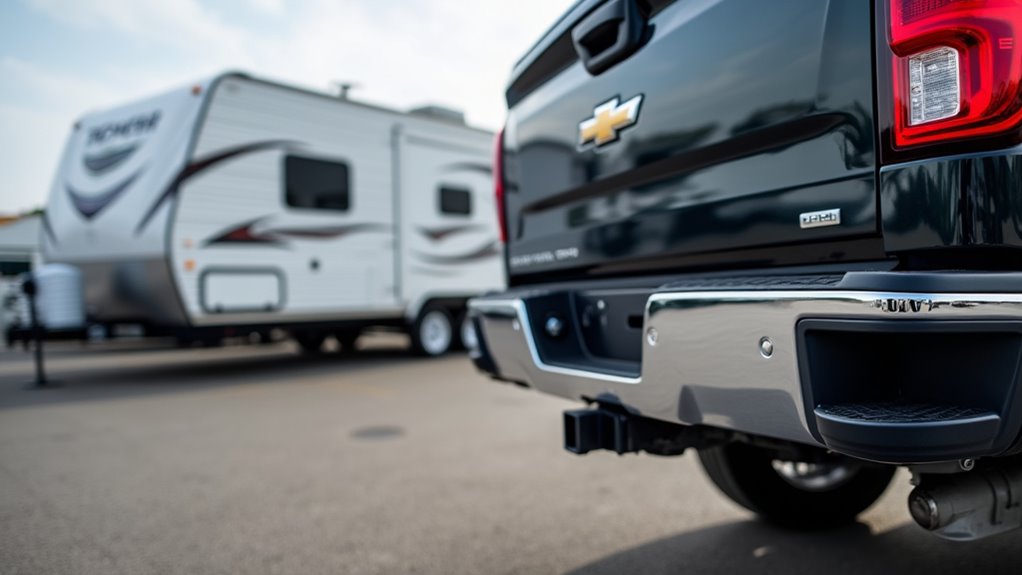
Your vehicle’s towing capacity sets the foundation for every RV rental decision you’ll make. Check your owner’s manual for the manufacturer’s maximum towing specifications and Gross Combined Weight Rating (GCWR). This includes your vehicle, trailer, passengers, and all cargo combined. Understanding your towing limits ensures safety and helps prevent damage to your vehicle or trailer. Follow the 75% rule—choose trailers with a GVWR that’s less than three-quarters of your vehicle’s capacity. This provides an essential safety buffer. Don’t forget tongue weight, which transfers from the trailer to your hitch and affects handling. Different trailer types have varying requirements. Fifth wheels need specialized in-bed hitches, while travel trailers require standard receivers. Pop-ups are lighter and more forgiving for smaller vehicles. When calculating total cargo weight, plan for approximately 1000 pounds for larger RVs over 8000 pounds, 750 pounds for mid-size units, and 500 pounds for smaller trailers under 5000 pounds to account for cargo weight allowances. If your current vehicle can’t handle your desired trailer size, factor potential upgrade costs into your rental-versus-purchase decision.

Once you’ve narrowed down your RV rental options based on towing capacity, storage becomes your next major consideration—and it’s often more complex than renters initially expect. While you won’t own these vehicles, understanding storage implications helps you choose between RV and trailer rentals based on your long-term travel plans. Here’s what affects your storage decisions:
If you’re considering future ownership, trailers offer more flexible, affordable storage options than motorhomes. Many facilities provide 24-hour access for convenience, allowing you to retrieve your rental at any time for spontaneous trips. Plus, storage costs can vary significantly depending on the size and type of the vehicle, so it’s important to factor this into your overall budget.
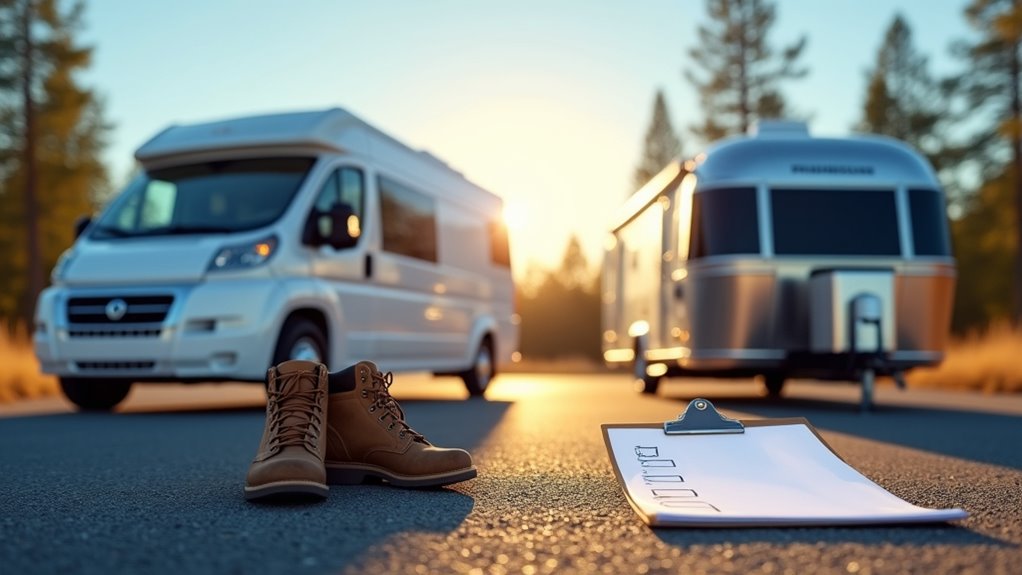
After considering storage logistics, you’ll want to make your rent-versus-buy decision using concrete factors rather than gut feelings.
Start by honestly evaluating your usage frequency—if you’re planning occasional weekend trips, renting makes financial sense at $184/day average. However, frequent travelers who’ll use an RV regularly should consider ownership despite higher upfront costs.
Assess your financial readiness for both scenarios. Factor in rental fees that can increase 50% above base rates, versus ownership costs including maintenance, insurance, and steep depreciation. Research shows RV ownership can deliver up to 60% savings compared to traditional air travel and hotel accommodations for families.
Consider your comfort level with mechanical upkeep—owners handle all repairs and winterizing, while renters get professionally maintained units. Plus, think about the long-term costs associated with ownership, which can influence your decision.
Finally, weigh flexibility against freedom. Renting offers variety and zero commitment, while ownership provides spontaneous travel opportunities and complete customization control.
You’ve weighed the numbers, compared your options, and now it’s time to pull the trigger. Whether you’re counting pennies or prioritizing convenience, your decision boils down to honest self-assessment. Can’t tow? Go RV. Weekend warrior? Consider a trailer. Your wallet, travel style, and storage situation will guide you to the right choice. Don’t overthink it—both options beat expensive hotels and restaurant meals hands down.